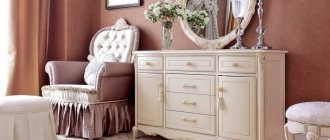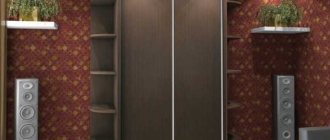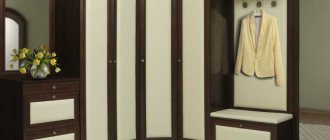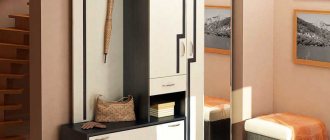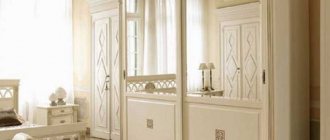<
>
A shoe stand is a popular accessory in the interior design of a small apartment, where it is not possible to install a special cabinet for storing shoes or to arrange a separate dressing room. The furniture industry, taking into account the constantly growing interest, today offers a large assortment of furniture items for the systematic storage of shoes, boots and other products of the footwear industry.
Shoe stand in the hallway - features and distinctive features
The main difference between a shoe stand and other types of shoe racks is its small size and simplicity of design. The product is a rack consisting of several tiers. A compact piece of furniture allows you to rationally use the square meters of the hallway or corridor and gives the premises a neat appearance.
In addition to saving usable space, the shoe rack has other advantages:
- functionality - the upper tier of the product can be used to store bags, keys and other small items. Some models are equipped with a special compartment for storing umbrellas;
- practicality - the design of the storage system allows you to quickly find the necessary pair of shoes; cleaning the hallway takes much less time and effort.
A stand for shoes and shoes is usually placed along the wall of the hallway or corridor; there are also models installed in a closet, built into niches or small sofas.
Types, design and rules for choosing shoe stands
Modern racks for shoe products differ in configuration, technical parameters, and color design. When choosing a storage system, it is important to take into account all the features of the piece of furniture; the shoe rack should be harmoniously combined with the design of the hallway.
What are shoe stands made of - types of materials
The furniture market offers stands for shoes made from various types of materials - metal, plastic, wood.
<
>
Metal shelves are characterized by a long service life, high strength, resistance to moisture and ease of maintenance. For lovers of luxurious and extraordinary furniture there are stands with forged elements.
Plastic models are a budget option for shoe storage systems. Plastic products are not distinguished by their visual appeal and long service life, and are subject to mechanical damage.
A shoe rack made of wood in the hallway is characterized by an attractive appearance and a long service life. The segment of wooden models is quite wide; manufacturers offer both budget products accessible to a wide range of consumers and elite stands made of expensive wood.
Design features and types of frames
The main elements of shoe stands are the frame and shelves. Based on the type of frame, there are two main types of shoe storage systems:
- open;
- closed.
The classic open stand consists of two or three tiers; racks with more than three shelves are quite rare. Some storage models are equipped with an additional top shelf, which can be used to place handbags, phones and other oversized items. Open models do not contain doors, shoes and boots always remain in sight, access to shoes is free.
Before choosing an open type shoe rack, you should pay attention to the height of the shelves. Sections located at different levels allow you to store different types of shoes; low shelves are for storing shoes, slippers, etc., high shelves are for winter shoes and boots.
In closed stands, shoes are hidden behind doors. Products can be equipped with folding shelves or wicker baskets. Unlike open models, closed stands prevent dust from getting on your shoes.
<
>
The design of the shoe stand frame can be collapsible or solid. On the furniture market there are also models of stands equipped with a soft seat.
Types of shelves for storing shoes
Shoe shelves can be made in the form of pallets or mesh. The one-piece design of the shelves protects the hallway floor from dirt; all the dirt that forms on the soles of street shoes flows into the tray. Mesh structures ensure natural drying of shoes due to free air circulation.
Types of storage systems
Shoe racks come in open and closed types. There are also models that combine closed sections and open shelving. Each option has its pros and cons.
Shelving
Floor shelving is a simple design where straight or inclined shelves are mounted on side posts. Models are completely open without sides and back walls, of different heights and sizes, or with blank walls. The undoubted advantage of these models: good ventilation, visual overview of the contents and ease of use.
The simplest option is a shoe rack
This is furniture up to 80 cm high, 50 cm wide, and 35 cm deep. The stands have 2 to 5 shelves. This furniture can only accommodate ballet flats or sneakers.
To store boots of all seasons, it is better to purchase models with additional high sections. In them, high boots can be placed on a shelf or hung on special fittings.
A rack is the simplest and most economical option for storing shoes
The stands can be combined with the seating area. In this case, the furniture is made with an average height of 50 cm from durable materials that can withstand the weight of a person.
A rack with a seat will be an alternative to a pouf or bench
Tall stationary shelving is mainly purchased for dressing rooms. Numerous open shelves from floor to ceiling significantly spoil the interior. In any hallway it is advisable not to place an open shoe rack higher than 80 cm.
The disadvantage of shoe racks like racks is the openness of the design.
Shoes are always in sight, should be thoroughly cleaned and beautifully arranged. Since the interior space is not protected - dust accumulates on the shelves, damage to the boots by animals is possible.
Hanging shoe racks
This is furniture equipped with special fittings for hanging on the wall. It comes in the form of simple organizers and racks. It is advisable to hang such models on the wall only if the order is carefully observed; the shoes should look neat and, as it were, decorate the wall. Otherwise, the hallway will feel like constant chaos.
In hanging racks, all shoes should look neat
Another option is to hang shelving in an out-of-sight area, between a closet and a wall or behind a door. In this case, discomfort may occur when removing shoes.
In closed wall-mounted models, the slipper storage system is located on the door or inclined, this makes it possible to make narrow cabinets without sacrificing capacity.
Closed cabinets perfectly hide shoes from prying eyes and free up space in the hallway
Hanging options save up to 20% of functional space. Medium-sized hanging cabinets made of light materials or with a mirrored facade give the room visual volume.
Stationary cabinet
Standard wardrobes can have hinged or sliding doors in a compartment type. Typically, cabinets are made in the form of modules in the form of a narrow pencil case and are combined with other furniture in the hallway. Depending on the model, it is suitable for medium-sized and spacious hallways.
You can store casual and seasonal shoes in them. Depending on the location of the shelves and sections, you can place shoes of different heights.
A regular shoe cabinet is a standard solution for the hallway
Slim wardrobe
All narrow cabinets with a depth of only 30 cm are combined under the name “slim”. Despite their compactness, due to their special design they have a large capacity. The furniture is equipped with 45° or 90° hinged doors, inclined or straight shelves. Many models are only suitable for low shoes, but there are modifications with high shelves.
The slim closet is narrow in size thanks to the storage of shoes at an angle
Cabinets are convenient for small hallways - they can be placed in a very narrow space. For example, behind the door. Disadvantages of furniture: unreliable stability on the floor. Therefore, it is better to mount them to the wall.
Wardrobe boom
This cabinet is made as a display stand with a large number of shelves, which are located at right angles or slopes. Advantages of furniture: large capacity and good ventilation. There are open and closed types.
The boom closet involves open storage of shoes
Nightstands and chests of drawers
This is a diverse group of furniture, the models of which differ in design and dimensions.
It is fashionable to fit up to 8 pairs of shoes in a cabinet or chest of drawers
The difference between cabinets and chests of drawers is only in size: chests of drawers are more spacious, cabinets are compact. The furniture is designed to store casual shoes, generally accommodating no more than 8 pairs.
The chest of drawers does not require storing a huge number of pairs of shoes
Depending on the model, cabinets and chests of drawers are:
- with folding or hinged doors;
- with one or many sections;
- with straight shelves or segments;
- with additional drawers for accessories.
The shoe rack can combine open and closed storage systems. These models are convenient because everyday shoes can be placed in an accessible place, and other items can be hidden behind the canvas.
An open shoe rack is the most convenient option for a small hallway
Corner shoe racks
Corner furniture almost always uses the “dead” space of the hallway - important for cramped rooms. Models are made in the form of all the designs described above, which can be combined. Corner furniture makes any hallway spacious and neat.
The corner shoe rack can also be equipped with a seat
Combined models
Combination options, clothes hangers, drawers for accessories, mirrors and seats for changing shoes - includes all the necessary furniture for the hallway. This eliminates the tedious selection of individual pieces of furniture and saves room space. Combined models come in different shapes, sizes, contents - you can choose the right number of shoes, clothes and accessories.
Combined shoe racks combined with a wardrobe system are used in small apartments to save space
Closed systems have standard or folding shelves. In folding models, the shelves are attached to the doors, and the structure itself is fixed on rotary hinges. This modification allows you to make narrow furniture without sacrificing spaciousness.
Operational features and rules for storing shoes on shelves
In order for the furniture to last for many years, it is important not only to choose the right shoe stand, but also to use it correctly. Shoe racks should be kept clean.
The key rules for storing shoes on stands are as follows:
- On one shelf, shoes should be stored in one row;
- It is not recommended to place wet shoes from the street on wooden stands. Shoes, boots and shoes should be dried first. High humidity can negatively affect the condition of wooden shelves;
- mesh structures are designed for storing clean shoes; boots and shoes should first be cleaned of dirt.
Closed storage methods
- Drawers.
One of the ways to hide shoes from view and from dust, but this design will take up more space than a shelf - after all, additional mechanisms and fasteners are needed to pull out the drawer. Another similar option is pull-out shelves. It's almost the same as boxes.
They have a smaller height and the shoes lie neatly on them in one layer. This is convenient if the closet is deep, but you have to look into it somehow to find the right pair.
- Shelves with doors under the seat.
Comfortable and functional - when putting on your shoes, you still have to bend over to untie the laces or fasten the lock. So wouldn’t it be better to choose an ottoman or a bench under which you can temporarily “hide” your shoes.
- Baskets.
A storage method for shoes that are not important to keep their shape. These are slippers and flip flops. Baskets can be solid or wicker, wooden, plastic and metal - the choice depends only on the preference of the buyer.
- Horizontal shelves for shoes in a dressing room with hinged doors or sliding doors.
As in the open version, the entire section is allocated for them or placed at the bottom.
- Galoshnitsa.
Narrow closed shelf for shoes with one or two crossbars. Strongly resembles a chest of drawers, but it only has two front legs. They are missing from the back so that you can mount it close to the wall. The kit includes special fastenings. They come in single and modular versions, but all have sliding doors. A shoe rack, or as it is also called, a shoe rack for a wardrobe, is one of the best storage solutions.
All of the described shoe shelves, whether they are in a dressing room or a closet, are good storage options. It is important to choose the right one.
Photo of shoe stands
<
>
The hallway is the calling card of each apartment. Storing shoes, boots and boots on the floor in the hallway not only gives the room a cluttered appearance and leads to unsanitary conditions, but also negatively affects the condition of the shoes themselves. A shoe stand will protect boots and shoes from deformation, free up usable space and ensure cleanliness in the house!


